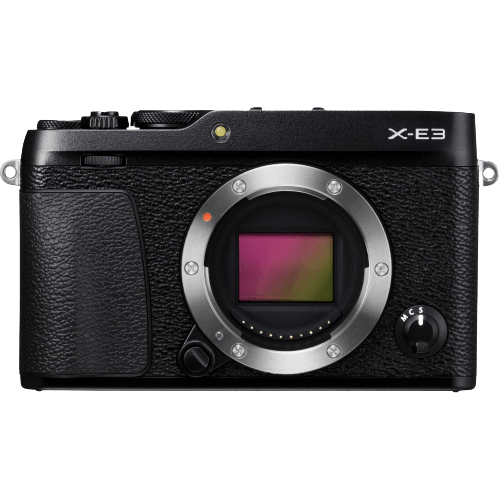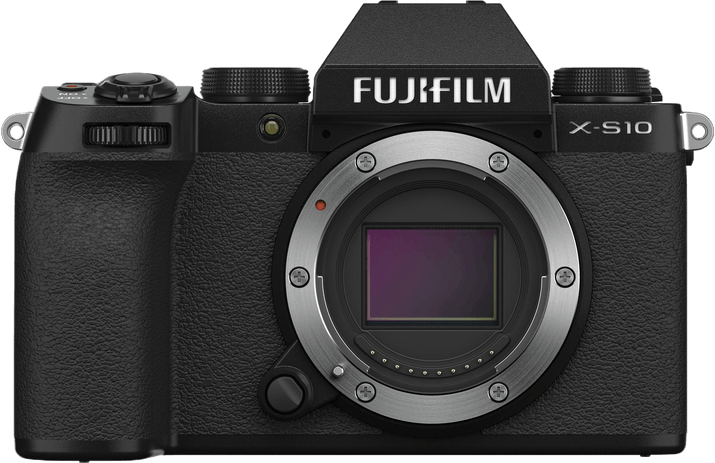Fujifilm X-E3 vs X-S10 Comparison
Fujifilm X-E3

Fujifilm X-S10

The Fujifilm X-S10 takes the lead with a score of 69/100, while the Fujifilm X-E3 trails behind at 63/100. Both cameras are mirrorless and were launched in 2017 and 2020, respectively. They share similarities in their camera type and launch prices of $899 for the X-E3 and $999 for the X-S10.
The X-S10 outshines the X-E3 in terms of its higher score and more recent release. However, the X-E3 has its advantages, including a lighter weight of 337g compared to the X-S10’s 465g, and a more compact size of 121 x 74 x 43mm against the X-S10’s 126 x 85 x 65mm.
Considering these factors, the X-S10 is the better camera due to its higher score and recent release, while the X-E3 offers a more lightweight and compact option for users who prioritize portability.
Fujifilm X-E3 vs X-S10 Overview and Optics
The Fujifilm X-S10 takes the lead in optics with a score of 72/100, compared to the Fujifilm X-E3’s 64/100. Both cameras share several common specifications, such as the CMOS sensor type, APS-C sensor size, and Fujifilm X lens mount. Despite these similarities, the X-S10 outperforms the X-E3 in certain aspects, while the X-E3 has some advantages as well.
The Fujifilm X-S10 excels with its higher megapixel count of 26, compared to the X-E3’s 24 megapixels. This allows for more detailed images and better overall image quality. Additionally, the X-S10 boasts a remarkable shooting speed of 20 frames per second, significantly faster than the X-E3’s 8 frames per second. This makes the X-S10 better suited for capturing fast-moving subjects and action shots. The X-S10 also features the more advanced X-Processor 4, which contributes to its improved performance. Furthermore, the X-S10 has built-in image stabilisation, which is absent in the X-E3, providing sharper images and smoother videos.
On the other hand, the Fujifilm X-E3 has the X-Processor Pro, which is still a capable processor, despite being older than the X-S10’s X-Processor 4. This allows the X-E3 to produce good image quality and decent performance, although not as impressive as the X-S10.
Taking these points into consideration, the Fujifilm X-S10 emerges as the superior camera in terms of optics, with its higher megapixel count, faster shooting speed, advanced processor, and image stabilisation. However, the Fujifilm X-E3 remains a viable option for those seeking a more affordable alternative with decent performance and image quality.
Fujifilm X-E3 vs X-S10 Video Performance
The Fujifilm X-S10 outperforms the Fujifilm X-E3 in video capabilities, scoring 91 out of 100 compared to the X-E3’s 69. Both cameras share common specifications, such as 4K max video resolution. However, the X-S10 boasts superior features that contribute to its higher score.
The X-S10 has a higher max video dimension of 4096 x 2160, compared to the X-E3’s 3840 x 2160. This difference allows the X-S10 to produce more detailed and higher quality video content. Additionally, the X-S10 has a significantly higher max video frame rate of 240fps, while the X-E3 reaches only 60fps. This higher frame rate enables the X-S10 to capture smoother video and slow-motion footage, providing more versatility for videographers.
Another advantage of the X-S10 is its built-in time-lapse functionality, which the X-E3 lacks. This feature allows users to create stunning time-lapse videos without the need for additional software or equipment.
While the X-E3 falls short in comparison to the X-S10, it still offers respectable video capabilities. Its 4K max video resolution and 60fps frame rate are suitable for most casual videography needs. However, the X-S10’s higher max video dimensions, frame rate, and built-in time-lapse functionality make it the superior choice for those looking to create more professional and versatile video content.
Considering the differences in video capabilities, the Fujifilm X-S10 is the clear winner for videographers seeking advanced features and higher quality footage. The Fujifilm X-E3 remains a viable option for casual users, but those looking for a more versatile and powerful video tool should opt for the X-S10.
Fujifilm X-E3 vs X-S10 Features and Benefits
The Fujifilm X-E3 and the Fujifilm X-S10 are both feature-rich cameras, with the X-E3 taking the lead by 22 points. When it comes to shared specifications, both cameras have a 3-inch screen size and a screen resolution of 1,040,000 dots. They also both have touchscreens and Bluetooth connectivity.
The Fujifilm X-E3 outshines the X-S10 in terms of features as it has built-in Wi-Fi, allowing for easy sharing and transfer of photos. This is a significant advantage for photographers who want to quickly share their images with others or upload them to social media platforms. The absence of Wi-Fi in the X-S10 is a drawback for those who value this convenience.
On the other hand, the Fujifilm X-S10 has a flip screen, which the X-E3 lacks. This feature is beneficial for users who need to shoot from various angles, such as capturing low-angle shots or taking self-portraits. The flip screen also allows for easier framing and composition in challenging situations. Despite not having Wi-Fi, the X-S10’s flip screen feature may be more important for some photographers.
Neither camera has GPS, which could be a disadvantage for those who want to geotag their images for precise location information. However, this may not be a crucial feature for all users.
In comparing the two cameras, the Fujifilm X-E3 offers the advantage of Wi-Fi connectivity, while the X-S10 provides a flip screen for versatile shooting. Depending on individual preferences and needs, users can decide which camera suits their requirements better.
Fujifilm X-E3 vs X-S10 Storage and Battery
The Fujifilm X-S10 outperforms the X-E3 in storage and battery with a score of 35/100 compared to the X-E3’s 21/100. Both cameras feature a single memory card slot and accept SD, SDHC, and SDXC (UHS-I compatible) cards. However, the X-S10 holds an advantage with its USB charging capability, which the X-E3 lacks.
The X-E3 has a slightly longer battery life of 350 shots compared to the X-S10’s 325 shots, using the NP-W126S battery type. The X-S10 uses the NP-126S battery type. Despite the X-E3’s longer battery life, the X-S10’s USB charging option makes it more convenient for users, especially when on-the-go.
While the X-E3 has a minor advantage in battery life, the X-S10’s USB charging capability ultimately makes it the better choice for storage and battery performance.
Fujifilm X-E3 vs X-S10 – Our Verdict
Are you still undecided about which camera is right for you? Have a look at these popular comparisons that feature the Fujifilm X-E3 or the Fujifilm X-S10:

